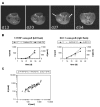Application of Benchtop-magnetic resonance imaging in a nude mouse tumor model
- PMID: 21777437
- PMCID: PMC3158420
- DOI: 10.1186/1756-9966-30-69
Application of Benchtop-magnetic resonance imaging in a nude mouse tumor model
Abstract
Background: MRI plays a key role in the preclinical development of new drugs, diagnostics and their delivery systems. However, very high installation and running costs of existing superconducting MRI machines limit the spread of MRI. The new method of Benchtop-MRI (BT-MRI) has the potential to overcome this limitation due to much lower installation and almost no running costs. However, due to the low field strength and decreased magnet homogeneity it is questionable, whether BT-MRI can achieve sufficient image quality to provide useful information for preclinical in vivo studies. It was the aim of the current study to explore the potential of BT-MRI on tumor models in mice.
Methods: We used a prototype of an in vivo BT-MRI apparatus to visualise organs and tumors and to analyse tumor progression in nude mouse xenograft models of human testicular germ cell tumor and colon carcinoma.
Results: Subcutaneous xenografts were easily identified as relative hypointense areas in transaxial slices of NMR images. Monitoring of tumor progression evaluated by pixel extension analyses based on NMR images correlated with increasing tumor volume calculated by calliper measurement. Gd-BOPTA contrast agent injection resulted in a better differentiation between parts of the urinary tissues and organs due to fast elimination of the agent via kidneys. In addition, interior structuring of tumors could be observed. A strong contrast enhancement within a tumor was associated with a central necrotic/fibrotic area.
Conclusions: BT-MRI provides satisfactory image quality to visualize organs and tumors and to monitor tumor progression and structure in mouse models.
Figures




References
-
- Strubing S, Abboud T, Contri RV, Metz H, Mader K. New insights on poly(vinyl acetate)-based coated floating tablets: characterisation of hydration and CO2 generation by benchtop MRI and its relation to drug release and floating strength. Eur J Pharm Biopharm. 2008;69:708–717. doi: 10.1016/j.ejpb.2007.12.009. - DOI - PubMed
Publication types
MeSH terms
Substances
LinkOut - more resources
Full Text Sources
Medical

